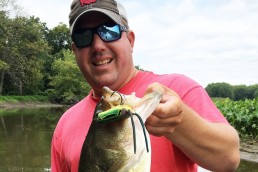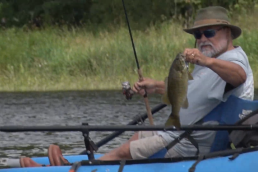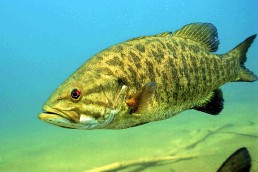Frog Fishing on the Mississippi River
SHARE THIS POST
Anglers across the nation use plastic frogs to catch largemouth and sometimes smallmouth bass on their favorite waters. However, on the Mississippi River, frog fishing is a mainstay, and knowing how and when to use a frog can be the difference between a few bites or a day to remember.
Adam Crigger, well-known Quad Cities angler and Mississippi River frog specialist, recently gave seminars on how he sets up for success to be a perennial favorite for many Mississippi River bass tournaments. If you are new to frog fishing, these tips could save you a season or two in experience.
“There are lots of sizes, brands and styles of frog that you can throw, and frog fishing has really evolved from only fishing matted lily pads, to something now that can be used virtually year-round on the river,” he began.
“I prefer the Spro Bronze eye frog 65 for a couple reasons. The first reason is, the hook is set tight to the body, keeping it weedless around wood, lotus or any other structures that you will be throwing at early in the year. The second reason is castability. When it comes to open-water frog fishing, the farther you can send that frog from the boat, the more likely you are to get bit,” he continued. When you are in shallow water, it is really easy to disturb fish. Being able to send that bait an extra 10 feet or more can make a substantial difference in the number of bites.
Early in the spring, he likes to use the 65, but will also use a popping frog once the bass go to beds. When bass have been on the beds a while, they do become conditioned to people flippin’ aggravation baits. The frog can give them something different to look at and which can be fished very slowly, keeping the bait within the zone the bass wants clear. The area directly above the bed can be just as intrusive as the sweet spot in the bed. Adam also described how he will switch to the poppin’ frog when fishing in deeper water, dirtier water, or if there is a chop on the water, all which are a little more aggressive to the fish.
In the post-spawn and while summertime fishing, he returns to more traditional techniques and fishes quickly. There are usually schools of fish chasing shad or bluegills in the pad fields, eelgrass, or milfoil with duckweed on top of it. When you find the fish, you can slow down and walk the bait to get another bite or two. Adam’s favorite time, though, is when the fish are chasing shad and “you can’t fish the frog fast enough.”
Are you enjoying this post?
You can be among the first to get the latest info on where to go, what to use and how to use it!
If the days are calm or you are chasing pressured fish, he may use the Spro Shad Frog because it is less intrusive and has a tighter walk, both of which can make the difference in getting those bites.
In the fall months, you should revert back to springtime tactics. Speed and water temperature go hand-in-hand, so the lower the temperature, the slower the movement. It is a great way to catch high-quality fish, but maybe not as many fish as you might with other techniques that time of year. If your goal is getting the 5 biggest bites you can on tournament day, this can be a go-to bait.
Adam will fish a frog directly out of the package 95 percent of the time, but there are situations when he will make minor tweaks to increase the catch. At times, he will add a couple BBs or other weights when fishing heavy winds or matted vegetations that is difficult to penetrate. He really does not add BBs for noise as many other anglers do. If he is consistently being “short-striked,” then a small trimming of the legs may be necessary. Making sure the hooks are sitting correctly on the frog is of huge importance as well. When the river conditions do not allow the use of a square bill, Spook or Pop-R because treble hooks continue to be fouled up, the frog can usually be fished in those conditions.
Next, when tying up a frog rod, you are going to need a long rod, but a sensitive tip to get that little bit of whip action for maximum distance. Adam, along with a handful of other Mississippi River anglers, helped design the Denali Attax Mississippi River series which was specific to those techniques on the Upper Mississippi River. He uses the 7-foot, 10-inch, extra-heavy slop rod most of the time because casting distance from the boat is many times the key to success. He pairs that rod with 60-pound braid to give him the power to set the hook and haul those fish back to the boat.
Finally, on a fish health note, frogs tend to be a lot easier on the fish than your treble hook baits. I grew up throwing a Pop-R bait and they are extremely effective on the river; however, the fish tend to swallow the entire bait. Trying to unhook a gut-deep treble hook from a fish tends to end in a bad day for the bass. Using a double-hooked frog will usually catch that fish with both hooks in the upper jaw, making it a cleaner catch, and a safer day for those bass.
Frog fishing is a year-long technique that can be used on the Upper Mississippi River. If you don’t have a frog rod tied up in your boat, you are missing a chance at some premium-quality bass nearly all year long.
MWO
SHARE THIS POST
Did you enjoy this post?
You can be among the first to get the latest info on where to go, what to use and how to use it!
Jeremiah Haas
As a full-time fisheries biologist on the Mississippi River, Jeremiah Haas is intimately tied to the outdoor resources surrounding the greater Quad Cities area and the Upper Mississippi River Basin. An accomplished hunter, fisherman and writer, Haas offers unique insight and perspective to MidWest Outdoors readers.



